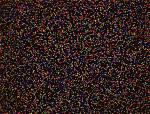This process can be used to sequence one string of single stranded DNA (ssDNA). The next key to NGS technology is to try to parallelize the process so we can perform many chemical reactions at the same time.
This is done by fixing the string of ssDNA on a solid surface called a "flow cell ." On different parts of the flow cell, different strings are fixed. Then the chemical reactions are run on the entire surface and a picture is taken of the surface.
This surface of the flow cell (pictured) has many little dots of light showing which nucleotide has been synthesized at each of the different strings attached to it.
 Each dot shows the position of a different ssDNA string that we have fixed onto the flow cell surface. There are different colors at each spot because the strings are different in their sequence.
Each dot shows the position of a different ssDNA string that we have fixed onto the flow cell surface. There are different colors at each spot because the strings are different in their sequence.
In the next step, all the lights will be turned off. Then, the next letter will be synthesized with a new set of light-producing nucleotides.
The color at each position will change because we can now detect the next nucleotide in the ssDNA string at each position on the surface. The machine keeps taking pictures and then reconstructs the sequence of colors from each spot, thereby reconstructing the sequence of nucleotides at that spot.
In a real NGS machine we would have billions and billions of such spots on the solid flow cell surface producing a sequence for billions of strings at the same time!,
Additional Resources
More details about sequencing-by-synthesis (video by NGS machine company, 4 minutes 22 seconds).


 Discovering the Genome
Discovering the Genome